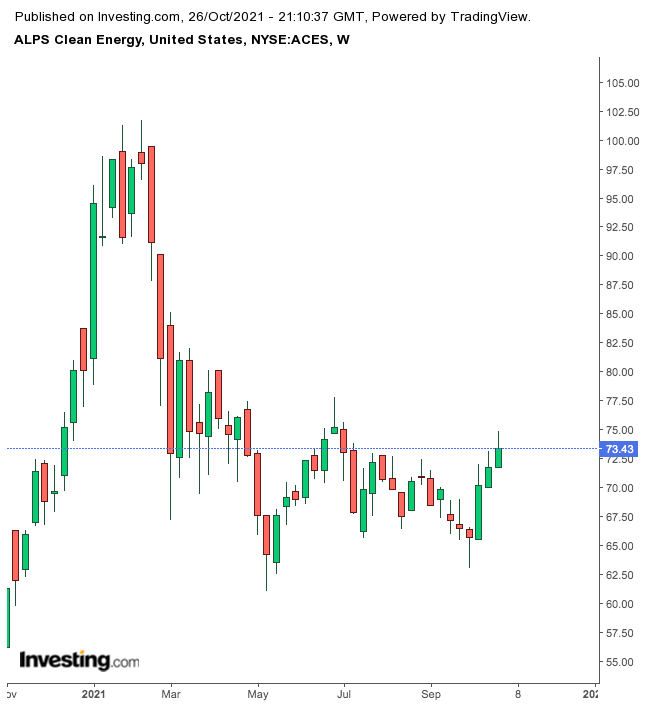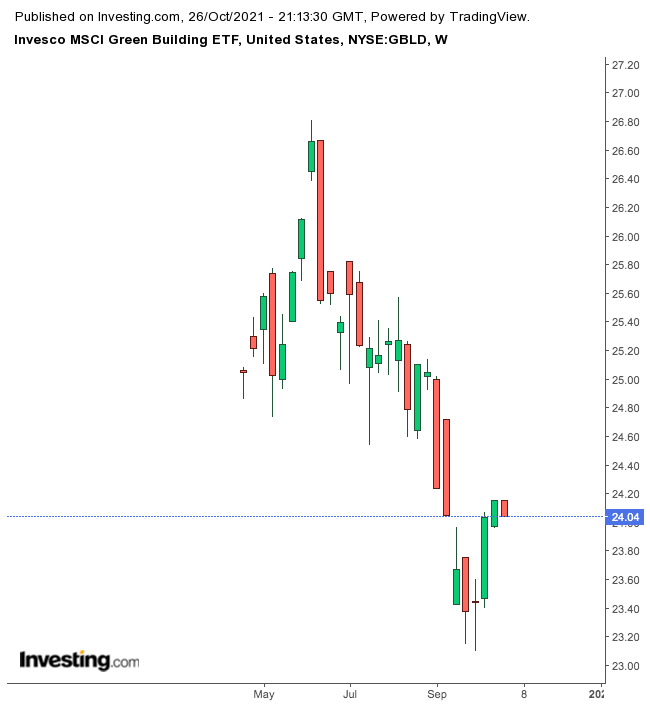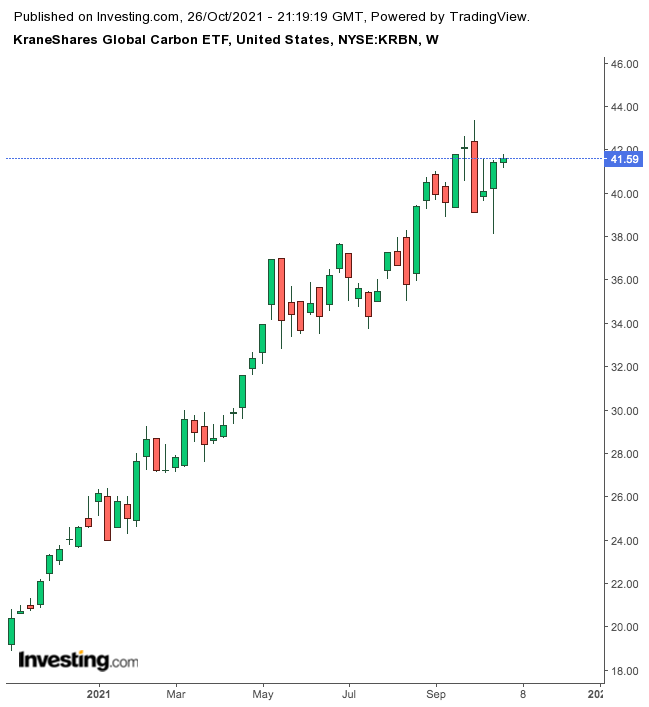The 26th United Nations' Climate Change Conference of the Parties, or COP26 Summit, will begin in Glasgow, Scotland, on Oct. 31. We recently introduced two exchange-traded funds (ETFs) that could appeal to readers interested in the alternative energy space. Today, we continue our discussion with three more funds.
1. ALPS Clean Energy ETF
- Current Price: $73.43
- 52-Week Range: $54.27– $101.72
- Dividend Yield: 0.56%
- Expense Ratio: 0.55% per year
The ALPS Clean Energy Fund (NYSE:ACES) invests in U.S. and Canadian firms focusing on clean energy. The fund was first listed in June 2018.

ACES has 40 holdings and tracks the Atlas Clean Energy Index. The top 10 names make up about half of its net assets of $1.02 billion. In terms of sub-sectors, solar has the biggest slice (23.95%), followed by wind (20.18%), electric vehicle/storage (13.34%), efficiency/LED/smart grid firms (10.50%) and fuel cell interests (9.88%).
Leading names include the EV heavyweight Tesla (NASDAQ:TSLA); hydrogen fuel cell specialist Plug Power (NASDAQ:PLUG); home solar and battery storage company Sunrun (NASDAQ:RUN), which manufactures photovoltaic solar modules, First Solar (NASDAQ:FSLR), and solar power and energy storage group Enphase Energy (NASDAQ:ENPH).
The fund, which returned 27.5% in the past year, is down more than 7% so far in 2021. After seeing a record high in February, ACES has lost more than 28%. Potential buy-and-hold investors could find value around these levels.
2. Invesco MSCI Green Building ETF
- Current Price: $24.04
- 52-Week Range: $23.10 - $26.81
- Dividend Yield: 2.88%
- Expense Ratio: 0.39% per year
The Invesco MSCI Green Building ETF (NYSE:GBLD) gives access to “sustainable construction” businesses. They mostly come from the real estate sector and focus on designing, constructing or redeveloping green-certified properties.
Recent research highlights state:
“Materials used in green buildings are local and promote sustainability, allowing ample energy savings and adequate natural light… Increasing demand for sustainable construction that can minimize energy consumption and improve performance, energy efficiency, and occupant’s comfort boosts market size.”

GBLD, which has 83 holdings, tracks the returns of the MSCI Global Green Building Index. More than 93% of the stocks come from the real estate sector, followed by consumer discretionary names (6.33%). The fund started trading in April 2021, and net assets stand at $4.4 million. In other words, it is a small young fund.
Real estate investment trust Alexandria Real Estate Equities (NYSE:ARE), which focuses on life science and technology campuses, Hong Kong-based Sun Hung Kai Properties (OTC:SUHJY), REIT Boston Properties (NYSE:BXP), which includes office, residential and hotel properties, Japanese REIT Nippon Building Fund (T:8951), and French real estate heavyweight WFD Unibail Rodamco (AS:URW) (OTC:UNBLF) lead the names in the roster.
Since its inception in late April, GBLD is down about 3%. Interested readers might want to keep the fund on their radar.
3. KraneShares Global Carbon ETF
Current Price: $41.59
52-Week Range: $18.88-$43.37
Expense Ratio: 0.78% per year
Our final fund for today might appeal to investors interested in emissions trading or the carbon cap-and-trade system. According to the Environmental Defense Fund:
“The best climate policy — environmentally and economically — limits emissions and puts a price on them…The cap on greenhouse gas emissions that drive global warming is a firm limit on pollution. The cap gets stricter over time. The trade part is a market for companies to buy and sell allowances that let them emit only a certain amount, as supply and demand set the price.”
The KraneShares Global Carbon ETF (NYSE:KRBN) gives access to the carbon allowances futures market. The fund tracks the IHS Markit Global Carbon Index, which covers the European Union Allowances (EUA), the Regional Greenhouse Gas Initiative (RGGI) and California Carbon Allowances (CCA).
Since the fund’s inception in July 2020, net assets have reached $1.03 billion.

Fund managers point out:
“…as of Dec. 31, 2020 the global price of carbon was $24.05 per ton of CO2. It is estimated that carbon allowance prices need to reach $147 per ton of CO2 to meet a 1.5°C global warming limit.”
In other words, KRBN might be appropriate for investors seeking exposure to the carbon credits market, especially in Europe. If an enterprise has high emission rates, it might need to buy extra carbon credits in the open market. Then “as the cost of carbon emissions rise, KRBN typically benefits, while companies with heavy carbon footprints typically suffer.”
A side note, Tesla generates significant revenue by selling extra regulatory credits to other companies. According to recent Q3 results, such credit sales accounted for $279 million of Tesla’s quarterly automotive revenue of $12.06 billion. To put that in perspective, Tesla’s regulatory credit sales amounted to about a fifth of the company’s free cash flow.
So far this year, KRBN is up 68.3%. Readers who also believe that the price of carbon could be higher in future quarters could consider buying the fund.
However, we should highlight that due to its exposure to EUA, KRBN has a large position in the euro. Therefore, currency fluctuations affect the value of the fund and KRBN could suffer when the U.S. dollar appreciates against the euro.
